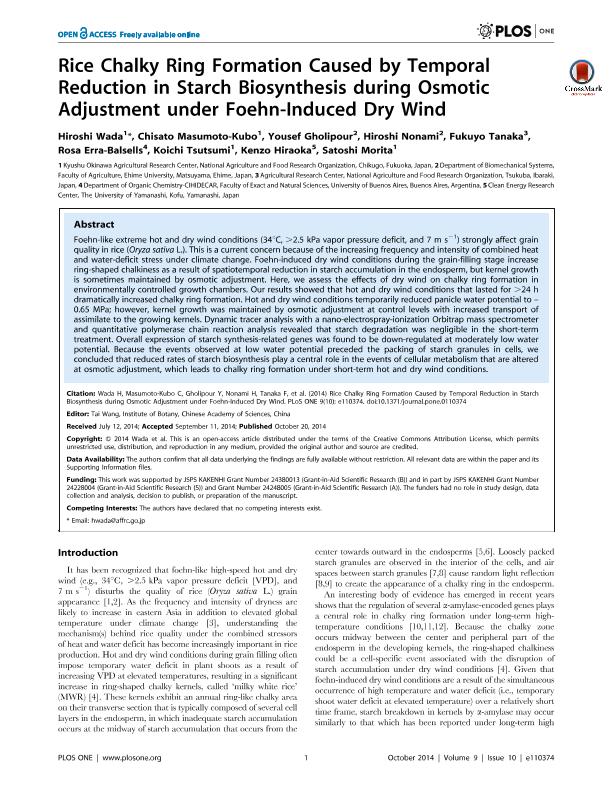Mostrar el registro sencillo del ítem
dc.contributor.author
Wada, Hiroshi
dc.contributor.author
Masumoto Kubo, Chisato
dc.contributor.author
Tsutsumi, Koichi
dc.contributor.author
Nonami, Hiroshi
dc.contributor.author
Tanaka, Fukuyo
dc.contributor.author
Okada, Haruka
dc.contributor.author
Erra Balsells, Rosa

dc.contributor.author
Hiraoka, Kenzo
dc.contributor.author
Nakashima, Taiken
dc.contributor.author
Hakata, Makoto
dc.contributor.author
Morita, Satoshi
dc.date.available
2018-09-07T19:36:13Z
dc.date.issued
2017-07
dc.identifier.citation
Wada, Hiroshi; Masumoto Kubo, Chisato; Tsutsumi, Koichi; Nonami, Hiroshi; Tanaka, Fukuyo; et al.; Turgor-responsive starch phosphorylation in Oryza sativa stems: A primary event of starch degradation associated with grain-filling ability; Public Library of Science; Plos One; 12; 7; 7-2017; 1-12
dc.identifier.issn
1932-6203
dc.identifier.uri
http://hdl.handle.net/11336/58819
dc.description.abstract
Grain filling ability is mainly affected by the translocation of carbohydrates generated from temporarily stored stem starch in most field crops including rice (Oryza sativa L.). The partitioning of non-structural stem carbohydrates has been recognized as an important trait for raising the yield ceiling, yet we still do not fully understand how carbohydrate partitioning occurs in the stems. In this study, two rice subspecies that exhibit different patterns of nonstructural stem carbohydrates partitioning, a japonica-dominant cultivar, Momiroman, and an indica-dominant cultivar, Hokuriku 193, were used as the model system to study the relationship between turgor pressure and metabolic regulation of non-structural stem carbohydrates, by combining the water status measurement with gene expression analysis and a dynamic prefixed 13C tracer analysis using a mass spectrometer. Here, we report a clear varietal difference in turgor-associated starch phosphorylation occurred at the initiation of non-structural carbohydrate partitioning. The data indicated that starch degradation in Hokuriku 193 stems occurred at full-heading, 5 days earlier than in Momiroman, contributing to greater sink filling. Gene expression analysis revealed that expression pattern of the gene encoding α-glucan, water dikinase (GWD1) was similar between two varieties, and the maximum expression level in Hokuriku 193, reached at full heading (4 DAH), was greater than in Momiroman, leading to an earlier increase in a series of amylase-related gene expression in Hokuriku 193. In both varieties, peaks in turgor pressure preceded the increases in GWD1 expression, and changes in GWD1 expression was correlated with turgor pressure. Additionally, a threshold is likely to exist for GWD1 expression to facilitate starch degradation. Taken together, these results raise the possibility that turgor-associated starch phosphorylation in cells is responsible for the metabolism that leads to starch degradation. Because the two cultivars exhibited remarkable varietal differences in the pattern of non-structural carbohydrate partitioning, our findings propose that the observed difference in grain-filling ability originated from turgor-associated regulation of starch phosphorylation in stem parenchyma cells. Further understanding of the molecular mechanism of turgor-regulation may provide a new selection criterion for breaking the yield barriers in crop production.
dc.format
application/pdf
dc.language.iso
eng
dc.publisher
Public Library of Science

dc.rights
info:eu-repo/semantics/openAccess
dc.rights.uri
https://creativecommons.org/licenses/by-nc-sa/2.5/ar/
dc.subject
Rice
dc.subject
Stress
dc.subject
Carbohydrates
dc.subject
Ms
dc.subject.classification
Otras Ciencias Biológicas

dc.subject.classification
Ciencias Biológicas

dc.subject.classification
CIENCIAS NATURALES Y EXACTAS

dc.title
Turgor-responsive starch phosphorylation in Oryza sativa stems: A primary event of starch degradation associated with grain-filling ability
dc.type
info:eu-repo/semantics/article
dc.type
info:ar-repo/semantics/artículo
dc.type
info:eu-repo/semantics/publishedVersion
dc.date.updated
2018-09-07T13:50:13Z
dc.journal.volume
12
dc.journal.number
7
dc.journal.pagination
1-12
dc.journal.pais
Estados Unidos

dc.journal.ciudad
San Francisco
dc.description.fil
Fil: Wada, Hiroshi. National Agriculture and Food Research Organization; Japón
dc.description.fil
Fil: Masumoto Kubo, Chisato. National Agriculture and Food Research Organization; Japón
dc.description.fil
Fil: Tsutsumi, Koichi. National Agriculture and Food Research Organization; Japón
dc.description.fil
Fil: Nonami, Hiroshi. National Agriculture and Food Research Organization; Japón
dc.description.fil
Fil: Tanaka, Fukuyo. National Agriculture and Food Research Organization; Japón
dc.description.fil
Fil: Okada, Haruka. National Agriculture and Food Research Organization; Japón
dc.description.fil
Fil: Erra Balsells, Rosa. Consejo Nacional de Investigaciones Científicas y Técnicas. Oficina de Coordinación Administrativa Ciudad Universitaria. Centro de Investigaciones en Hidratos de Carbono. Universidad de Buenos Aires. Facultad de Ciencias Exactas y Naturales. Centro de Investigaciones en Hidratos de Carbono; Argentina
dc.description.fil
Fil: Hiraoka, Kenzo. The University of Yamanashi; Japón
dc.description.fil
Fil: Nakashima, Taiken. National Agriculture and Food Research Organization; Japón
dc.description.fil
Fil: Hakata, Makoto. National Agriculture and Food Research Organization; Japón
dc.description.fil
Fil: Morita, Satoshi. National Agriculture and Food Research Organization; Japón
dc.journal.title
Plos One

dc.relation.alternativeid
info:eu-repo/semantics/altIdentifier/doi/https://dx.doi.org/10.1371/journal.pone.0181272
dc.relation.alternativeid
info:eu-repo/semantics/altIdentifier/url/https://journals.plos.org/plosone/article?id=10.1371/journal.pone.0181272
Archivos asociados
